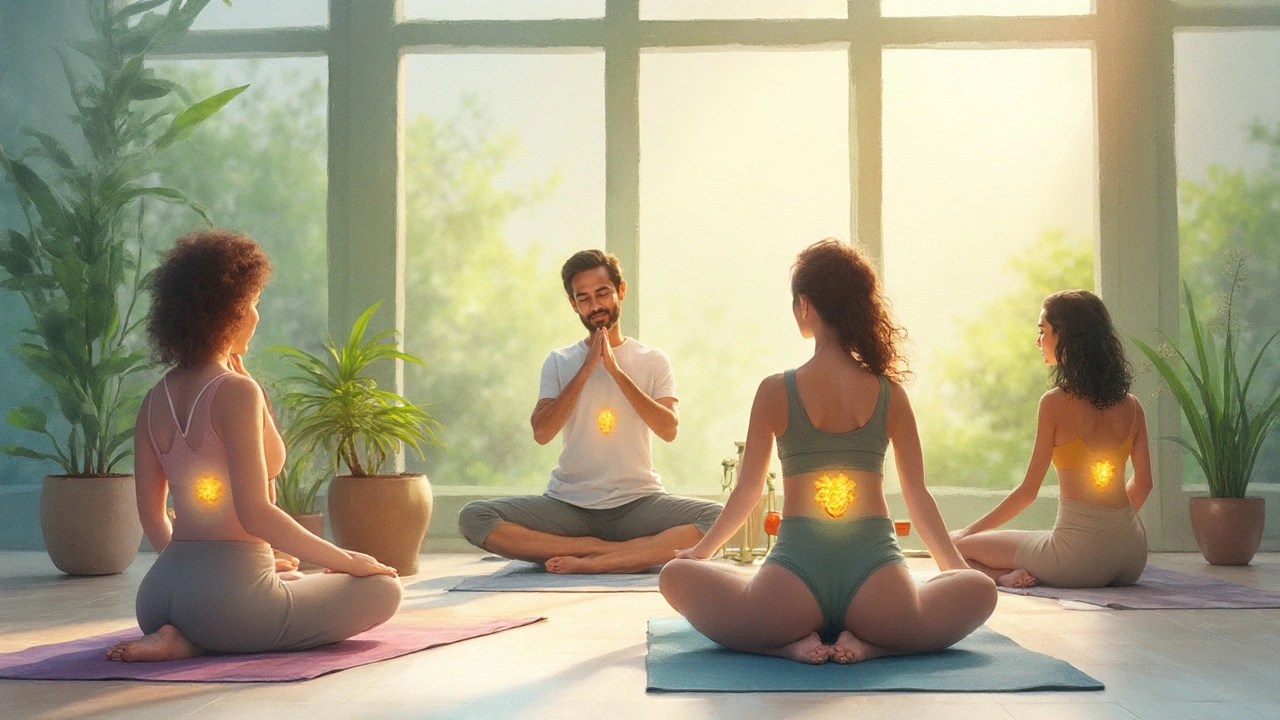TL;DR
- Yoga and meditation lower stress, a major trigger for colitis flare‑ups.
- Gentle poses improve gut motility and reduce abdominal pain.
- Mindfulness breathing balances the autonomic nervous system, cutting inflammation.
- Regular practice can complement medication, often reducing dosage needs.
- Start with 10‑15minute sessions, three times a week, and track symptoms.
Yoga is a physical‑mind practice that blends postures, breath work, and meditation to promote flexibility, strength, and mental calm. For people living with colitis - an inflammation of the colon - yoga offers a low‑impact way to move the body without aggravating the digestive tract.
Alongside yoga, Meditation is a mental discipline that trains attention and awareness, often using breath or mantra as an anchor. When practiced consistently, meditation dampens the stress response that frequently fuels colitis flare‑ups.
Understanding Colitis and Its Triggers
Ulcerative colitis is a form of inflammatory bowel disease (IBD) characterized by continuous inflammation of the inner lining of the colon. While genetics set the stage, environmental factors-especially chronic stress-can dictate when the disease erupts.
The gut microbiome refers to the community of bacteria, fungi, and viruses living in the digestive tract plays a vital role in modulating inflammation. Stress‑induced changes in the microbiome often worsen colitis symptoms.
How Yoga Directly Impacts the Digestive System
Yoga targets the autonomic nervous system the part of the nervous system that controls involuntary functions like heart rate, digestion, and respiratory rate. By activating the parasympathetic (rest‑and‑digest) branch, yoga slows gastric motility, reduces spasm, and eases cramping.
Specific gentle yoga poses postures such as Child’s Pose, Supine Twist, and Cat‑Cow that are safe for inflamed abdomens encourage gentle compression and release of the abdominal organs, promoting better peristalsis without over‑stretching delicate tissues.
Meditation’s Role in Stress Reduction and Inflammation Control
When the brain perceives a threat, it releases cortisol and adrenaline, hormones that can aggravate the intestinal lining. Regular mindfulness meditation focuses attention on the present moment, often through breath observation, reducing rumination and anxiety helps lower these stress hormones.
Studies from leading gastroenterology centers (e.g., Johns Hopkins) show that patients who practice mindfulness for eight weeks experience a 30% reduction in self‑reported flare frequency, likely due to a calmer hypothalamic‑pituitary‑adrenal axis.
Breathing Exercises: The Bridge Between Yoga and Meditation
Pranayama is a set of controlled breathing techniques used in yoga to regulate the flow of prana (life energy). Techniques like diaphragmatic breathing or alternate‑nostril breathing directly stimulate the vagus nerve, a key conduit of the parasympathetic system.
Activating the vagus nerve improves gut motility and has been shown to reduce inflammatory cytokine levels (IL‑6, TNF‑α) by up to 25% in small clinical trials involving IBD patients.

Putting It All Together: A Sample Weekly Routine
- Monday - 15‑minute gentle flow: Start with 3minutes of diaphragmatic breathing, then move through Child’s Pose, Cat‑Cow, Supine Twist, and finish with Savasana.
- Wednesday - 10‑minute mindfulness: Sit comfortably, set a timer for 10minutes, focus on the breath, gently bring attention back whenever the mind wanders.
- Friday - 20‑minute combined session: Begin with 5minutes of alternate‑nostril breathing, flow through the same gentle poses, and close with a 5‑minute body‑scan meditation.
Track pain levels, stool frequency, and mood in a journal. Many sufferers notice a steady decline in pain scores after 4-6 weeks.
Comparison of Complementary Therapies for Colitis
| Therapy | Primary Focus | Typical Session Length | Key Benefit for Colitis |
|---|---|---|---|
| Yoga | Physical movement + breath | 10‑30min | Reduces abdominal muscle tension, improves gut motility |
| Meditation | Mental focus & awareness | 5‑20min | Lowers cortisol, dampens inflammatory response |
| 5‑ASA Medication | Anti‑inflammatory drugs | Daily oral dose | Directly reduces colon inflammation |
While medication attacks inflammation chemically, yoga and meditation tackle the root stressors that often trigger those chemical cascades. Using them together can lead to lower medication dosages and fewer side‑effects.
Potential Pitfalls and How to Avoid Them
Not every pose is safe during an active flare. Avoid deep backbends, intense abdominal compression, or any movement that causes sharp pain. If a pose feels uncomfortable, modify with props-bolsters, blankets, or a sturdy chair.
Similarly, meditation should never become a mental marathon. Starting with just a few minutes prevents frustration and keeps the practice sustainable.
Related Concepts and Next Steps
Beyond yoga and meditation, consider integrating probiotic nutrition dietary intake of live beneficial bacteria to support gut flora balance. Fermented foods like kefir, sauerkraut, and miso can further calm inflammation.
For readers ready to dig deeper, the next logical topics are:
- “How a Low‑FODMAP Diet Reduces Colitis Symptoms”
- “Integrating Biofeedback Therapy with Mind‑Body Practices”
- “Evidence‑Based Supplements for IBD Management”
Each of these builds on the core principle that mind, body, and gut are interconnected.
Frequently Asked Questions
Can yoga replace my prescribed medication for colitis?
No. Yoga is a complementary tool that can reduce flare frequency and severity, but it doesn’t target the immune response the way drugs like 5‑ASA do. Always discuss any changes with your gastroenterologist.
What is the safest yoga style for someone with an active flare?
Gentle styles such as Restorative, Hatha, or therapeutic yoga classes that avoid deep twists and inversions are best. Focus on seated stretches and supported supine poses.
How long does it take to notice benefits from meditation?
Most people report reduced anxiety and better sleep within 2‑3 weeks of daily practice. Noticeable changes in flare frequency often appear after 6‑8 weeks of consistent mindfulness.
Are there any contraindications for pranayama breathing?
If you have severe asthma, uncontrolled hypertension, or recent abdominal surgery, avoid forceful breath holds. Stick to gentle diaphragmatic breathing and consult your physician if unsure.
What frequency of practice yields the best results?
Three to five short sessions per week (10‑20minutes each) strike a good balance between consistency and fatigue. The key is regularity, not duration.



